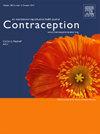DISTANCES TRAVELLED FOR ABORTIONS AND INEQUITIES FOR RURAL RESIDENTS IN OREGON
IF 2.8
2区 医学
Q1 OBSTETRICS & GYNECOLOGY
引用次数: 0
Abstract
Objectives
Abortion access is dire in most rural areas of the US. Recent studies have shown that most reproductive-aged women live greater than a 30 minute drive from the nearest abortion clinic. True travel distances to abortion care may be even higher, given restrictions in availability by type of abortion and gestational age. This study aims to describe the burden of travel to abortion care for residents of Oregon, a state with no legal restrictions on abortion, by rurality of residence.
Methods
We conducted a descriptive study of vital statistics from the Oregon Health Authority of all abortions in Oregon from 2015 to 2021. We calculated distances between county of residence and county of abortion occurrence.
Results
Of 57,533 abortions, 90% (n=51,781) were to Oregon residents. Individuals from every county in Oregon needed abortion care during our study period, however abortions were provided in only 25% of counties (n=9). Those that travelled outside their county for abortion care (n=21,808, 37.4%) travelled an average of 56 miles for abortion care. Residents of rural counties (n=4,284) had an average travel distance of 103 miles, with maximum distance travelled of 432 miles.
Conclusions
This recent, real-world study describes a high burden of travel for rural residents, even in a state where abortion is legal. This data can support efforts to creatively, strategically, and equitably increase access to abortion, particularly for those with geographic challenges to access.
俄勒冈州农村居民的堕胎路程和不公平现象
目标在美国大多数农村地区,堕胎的机会非常渺茫。最近的研究表明,大多数育龄妇女的居住地距离最近的人工流产诊所有 30 分钟以上的车程。由于人工流产类型和妊娠年龄的限制,人工流产护理的实际路程可能更远。俄勒冈州是一个对人工流产没有法律限制的州,本研究旨在描述俄勒冈州居民前往人工流产医疗机构的旅行负担,并按居住地的偏远程度进行分类。方法我们对俄勒冈州卫生局提供的 2015 年至 2021 年俄勒冈州所有人工流产的生命统计数据进行了描述性研究。我们计算了居住地所在县与堕胎发生地所在县之间的距离。在我们的研究期间,俄勒冈州每个县的居民都需要人工流产护理,但只有 25% 的县(n=9)提供了人工流产服务。到县外接受人工流产治疗的患者(人数=21,808,占 37.4%)平均需要走 56 英里才能接受人工流产治疗。农村县居民(n=4,284)的平均旅行距离为 103 英里,最远旅行距离为 432 英里。结论这项最新的真实世界研究描述了农村居民的高旅行负担,即使在堕胎合法的州也是如此。这些数据可为创造性地、战略性地、公平地增加堕胎机会提供支持,尤其是那些在地理位置上难以获得堕胎机会的人。
本文章由计算机程序翻译,如有差异,请以英文原文为准。
求助全文
约1分钟内获得全文
求助全文
来源期刊

Contraception
医学-妇产科学
CiteScore
4.70
自引率
17.20%
发文量
211
审稿时长
69 days
期刊介绍:
Contraception has an open access mirror journal Contraception: X, sharing the same aims and scope, editorial team, submission system and rigorous peer review.
The journal Contraception wishes to advance reproductive health through the rapid publication of the best and most interesting new scholarship regarding contraception and related fields such as abortion. The journal welcomes manuscripts from investigators working in the laboratory, clinical and social sciences, as well as public health and health professions education.
 求助内容:
求助内容: 应助结果提醒方式:
应助结果提醒方式:


